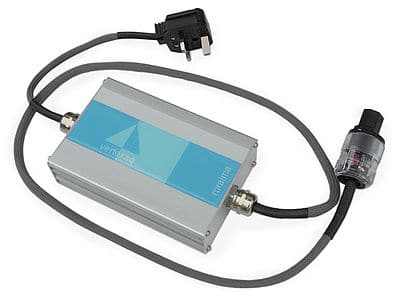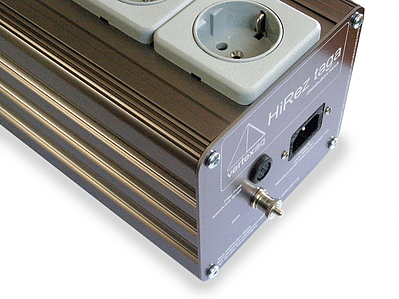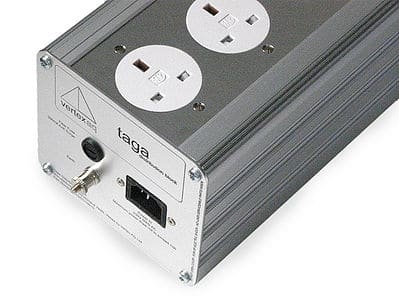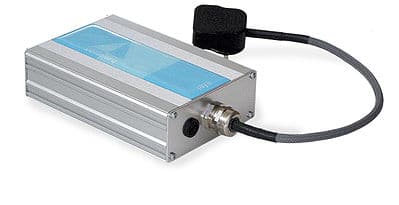The Article
Vertex AQ – Stage Two: eradicate your noise
2nd October 2015

Promising to eradicate your Hi-Fi’s RFI, EMI and acoustic transmission problems, Paul Rigby reviews the next level of the Vertex AQ system
This is part two of a system-wide investigation to reduce noise in my hi-fi system. I’ve spent a lot of money on my system, over many years. If I’ve learnt one thing, it’s not to pursue improved sound quality head on. What I have learned, through much frustration, is to actually remove noise. Because, my friends, if you remove the noise in your hi-fi then the sound quality will come trotting out of its hide-away and land in your ears of its own accord.
So, how do you remove noise? Well, I’ve experienced many frustrating years finding the answer to that too (being a hi-fi journalist includes lots of frustration…you get used to it). I’ve tested, loaned and reviewed many products from many companies who promise to do just that. Some of those products focused on shelving, others on isolation feet, some on interconnects and still more centred on room acoustics. All of these products were useful and all are still very important in the grand scheme of removing noise from your sonic life. Yet the core to the production of nasty frequencies emanated from the mains supply. That’s were the majority of the problems seemed to stem from.
So I homed into mains and heard a lot of theories and approaches to the problem. Again, I tested, loaned and reviewed but eventually I stumbled across Vertex AQ. What intrigued me about this company is that their products are passive to the ‘nth’ degree. They don’t propose to muck around with your mains supply. The don’t try to bend it, rebuild it, force it, suppress it or change it. That struck a chord with me because much of the competition removed a lot of noise but they also seemed to slice a part of the dynamics off the top of it. So, music had a beautifully crafted silence behind it but it often lost a bit of pizazz in the meantime.
I was cautious about Vertex AQ but was, refreshingly, also encouraged to be so by the company itself. I (and they) wanted me to take things very slowly. I wanted to be sure that what I was hearing from their kit was an actual improvement and not just something ‘different’. I also wanted to slowly apply their products to my entire system on a gradual basis and see what each piece of equipment actually did.
The kit itself, in very simple terms, was basically a bunch of mains leads and a power block. The cables themselves were decent but not eye-popping. The devil was in the box placed half-way along containing a complex filtering ‘labyrinth’, created using long-term mathematical research (developed by a post graduate in Applied Mathematics and experienced Military Consultant, Gareth Humphreys-Jones: see biography below). The bottom line is that the labyrinth helps to reduce noise from that connection. You can read more about it in the Stage One feature review accessible in the Hi-Fi Review section.
Basically, for Stage One, I connected Vertex AQ filter cables to my hi-fi but not to my electrostatic speakers: Quad ESL-57s. Why? Because I basically didnt have enough kit to go around. Simple as that. Hence, the speakers were out of the Vertex AQ loop. These fancy, boxed, cables (called Roraimas) were plugged into another filtered piece of kit, a power block called a Taga. In addition, I also received a shunt filter called a Silver Jaya which helped to improve the overall picture. The Jaya was plugged into the mains via the power block.
For Stage Two then, I received some new equipment, a high resolution variant of the Taga called, incredibly enough, the HiRez Taga plus a batch of additional Roraimas (with long leads) to enable the connection of my Quad speakers.
Before we get to the sound testing. I chatted to Steve Elford, MD for Vertex AQ on what I had received and the technologies behind them.
“Both Targas feature a single IEC input with six UK 13A sockets (or as pictured, European Schukos),” said Elford. “There’s quite a big cost difference between them but there’s a big technology difference too. What you’ve got is solid-core silver wiring (HiRez Taga) rather than silver-plated copper (basic Taga). Both Targas have two internal modules. The first is an acoustic absorption module that is in-line with the mains wiring from the inside of the IEC socket. It’s essentially a Roraima block, fitted inside. Also inside is a similar acoustic labyrinth that you’d see in a Roraima. The cable goes right through it and comes out the other side. That cable then splits into star wiring to feed six sockets.”
If you are not familiar with Star Wiring, check the explanation below. Both Tagas also have a Jaya Shunt filter in them (check the Stage One feature for more on that). The standard Taga has a Silver Jaya. That Jaya has silver wiring and it is connected at the point that the star wiring starts but the fat wire bit is still copper. The Jaya is connected across the mains because it’s a shunt filter. That is silver wired. The Silver Jaya also has its own acoustic labyrinth.
“In any of the Tagas there are two acoustic labyrinths: one in line, like a Roraima block plus the block fitted at the bottom of the chassis. The Hi-Rez Taga is basically the same layout but you’ve got solid core silver wiring labyrinths in the Silver Jaya block bit and the Roraima-type block bit but both also are a more complex labyrinth. The complexity of the build process is very different.”
That’s another reason for the increase in price. It doesn’t take more materials to build a more complex labyrinth in a Hi-Rez Taga but it does take more man-hours because there are more smaller bits to tackle and it takes longer to create. The thing is a bit like a jigsaw puzzle. The guts are then potted in resin. In the HiRez Taga the resin has a radar-absorption powder mixed into it. This is the same stuff used in the military aeronautics industry but also in medicine and mobile communications. It’s a nickel-compound designed to absorb electro-magnetic waves (EMI or radio waves). Fairly common in all of these industries, the hi-fi industry, oddly, has yet to really understand and use it.
“The EMI absorption compound that goes into the resin means that the radiation from the live, neutral and earth conductors are absorbed and drained away. This is why we don’t use much screening. Screening either reflects it or leaves the same amount of energy but just puts it in the earth. If you use absorptive techniques this helps.”
The Hi-Res Targa also has a soft silicon EMI absorbent tubing that covers the silver wiring plus a more complex shunt filter, with more circuit elements.
So why use solid silver wire and not copper?
“Signals move along silver, faster,” said Elford. “It has a lower impedance and so dumps noise quicker. Silver’s a funny thing. How many people have you heard say, ‘Well, silver’s supposed to be a better conductor but I don’t like the sound of silver interconnects.’ That’s because they don’t consider RF noise management. If you ignore noise and join Box A to Box B with a silver interconnect when both are generating a load of crap, the distortion goes up because the silver is also better at conducting noise as well as the music signal. At this point, people then return back to their copper cable. Much smoother, they say. Not so. If you absorb the EMI first and then use silver then you get massive benefits.”
SOUND TEST
I began the tests from the Stage One system already installed and then went from there with the Stage Two components added gradually, one element at a time, until Stage Two was complete.
Hence I already had a basic Taga power block installed plus a basic Jaya shunt filter attached and Roraima mains cables on my Icon Monoblock Power amps plus the Pre-Amp and Phono amp. I didn’t have enough Roraimas to handle all of my hi-fi kit so I still used a Tellurium Blue cable on my Avid turntable and a Black Rhodium Cratos on my CD player.
The first test was to add a Roraima cable to the Avid Acutus plus a Silver Jaya to the basic power block, the Taga.
Playing Yes’ Yours Is No Disgrace on vinyl, the most immediate change was the drum output on the upper levels of the soundstage, which now sounded integrated instead of just a bag of instruments thrown together.
They now had a much wider aspect too, spreading themselves over the upper layer, giving a rich playback. This, coupled with the reduction in noise, also gave each drum strike a ‘clean’ aspect. Speaking of which, the treble was also purified, allowing it to give a complex description of the cymbal work. Bass, intriguingly, became less ‘in your face’ and aggressive. In fact, Chris Squire’s bass guitar merged into the mix and becomes more interesting with extra personality, losing the former primordial grunt. Lastly, Steve Howe’s electric guitar, while retaining its forward nature, was tamed, becoming less obtrusive.
Moving to my CD player and Freddie Hubbard’s first album as leader, Open Sesame with Tina Brooks on sax. Featuring open upper mids, a more spacious soundstage with far less noise giving the midrange a cleaner presentation, the Vertex system sounded like the trumpet had passed through a filter (which, actually, it had), its output was smooth, gliding through the air. Treble seemed to have more space to expand into, giving it a frisson of extra shimmer. Sax was less aggressive on the ear. It’s output still pushed towards the extreme of forwardness but it no longer sounded as harsh or edgy.
The next test demanded that I change the basic Taga for the HiRez variant which was quickly followed by a jump in overall clarity over all frequencies of the Yes vinyl. The reduction in noise was, indeed, palpable which produced a great deal of calm and ease in the overall presentation. Two intriguing changes in the musical presentation were of note. Firstly, how even-handed was the master. Bass and upper mids were integrated together in a complimentary manner. Secondly, with the reshuffling, Tony Kaye’s Hammond organ emerged as a much more dominant instrument. Never in your face, the organ didn’t take over the track but it did play a bigger part in the structural rhythms.
There was a great focus to each individual instrument. Steve Howe’s guitar was brought further back into the mix, retaining detail but losing more of that forward brightness. That lowering of noise also revealed complex activity in the lower freqency regions, extracting, from the bass guitar, a wealth of detail.
Moving to Freddie Hubbard on CD, the upper registers of the trumpet and sax exhibited focus too, losing a lot of the bloom that previously created a fuzzy, indistinct confusion. There was now far more room for each band member to play. In fact, the group sounded like they were standing in a larger space. Frequencies also had a chance to tail off on the reverb level while the sax was no longer the almost stabbing noise that threatened to provide a headache, free of charge. It remained bold and strong but the emphasis was now in terms of emotion.
For the first time on this track I became more aware of the double bass, which was previously swamped by the upper frequencies, reflecting the change in the master presentation and the soundstage. The piano was also changed, being less meek and mild, providing a more telling contribution.
The next stage was to bring the rest of my hi-fi chain into the Vertex loop which meant re-employing the original Taga, which had been replaced by the HiRez Taga and was, thus, free to use with the speakers.
After plugging the electrostatic speakers into the basic Taga, the most obvious difference was the incredible width of the sound stage. I never knew my speakers were capable, to be frank but here it was, the left and right soundstage stretched off into the distance giving a more solid stereo image in the bargain. This increase in soundstage size gave the music an epic tone, a majestic feel that you were present at an ‘occasion’, that you were facing, in fact, a real stage. Another immediacy was the all round timing. Events began and stopped with a greater sense of urgency. Even reverb was now focused and more efficient.
In addition to the obvious was now the subtle. For example, Steve Howe now had reverb on his guitar. The fascinating thing was that the instruments he stood next to didn’t necessarily have the same reverb as his guitar. You could hear the difference.
The stress on Chris Squire’s bass was also noticeable. That is, the emphasis on each string, which added emotion to the Squire performance. The same could be said of Steve Howe’s acoustic strumming later in the track.
Overall, the layering of the instruments provided a new complexity that attracted the ear and encouraged it to search in and around each frequency.
On CD and spinning the jazz disc, the big news was that, with the expansion of the soundstage laterally, the percussion space was now stretched, allowing new detail to be exposed. Previously, it was so bunched up that the percussion appeared like a single noise. Now, there seemed to be new drums involved in the track, new strikes, new percussive elements to hear. The trumpet solo was fascinating if, for no other reason, than to track the reverb from it. The reverb was tight to the trumpet but present enough to give it a larger dimension.
The sax lost that brightness and forward nature now. It settled more into the mix which helped the ear to track the detail. Bass began to solidify while piano danced merrily with extra energy.
CONCLUSION
We are at Stage Two with this investigation and so a conclusion is almost an oxymoron because I feel like my system is on a journey. Conclusions are associated with endings and I can’t see that happening for some time. What I can see, though, is progress and lots of it. Each component of the Vertex AQ strategy looks like a brick in form and shape but that’s exactly what each element provides, a building brick to a better sounding system.
This review is also interesting because the point of the Vertex AQ components as a group is not what it can give you but how much it can take away. The more noise that the system removes, the better sounding the hi-fi becomes. As such, the systematic approach is not only evolutionary, it provides a gradual series of improvements, across the board.
Finally, in addition to the noise removal was the change in music structure and emphasis. There seemed to be a change in how the music was performed because noise was prevented from placing undue and false emphasis on certain instruments. I can’t wait for Stage 3.
RORAIMA MAINS LEADS
1.0m £394.87
1.5m £427.98
STANDARD JAYA MAINS FILTER – £401.06
SILVER PLUS JAYA – £644.33
STANDARD TAGA – £1,046.57
HIREZ TAGA – £2,300
THE VERTEX AQ SYSTEM STAGE 2
VERTEX AQ
Tel: 01554 759267
Website: vertexaq.com
Facebook: www.facebook.com/vertexaq
Good: passive filtering, easy to use, focus, low noise, wider soundstage
Bad: nothing
RATING: 8
REFERENCE SYSTEM
Avid Acutus Turntable
SME IV arm
Benz Glider cartridge
XTZ CD player
Aesthetix Calypso Pre
Icon Audio MB845 Mk.II monoblocks
Quad ESL-57 speakers with One Thing upgrade
STAR WIRING
“If you daisy chain one socket to the next then you get a messy arrangement where the last socket in line has the accumulated noise from the previous five screwed-up connections,” said Elford “It’s bad news. If you have a noisy product plugged into a daisy chained socket it pollutes the other sockets in line. If they are star wired, then the noise on one socket sees the Jaya immediately. It’s a kind of parallel system,” said Elford.
WARMING UP
As an aside, in the past, I have always tended to warm up my well worn-in hi-fi system for around 15-20 minutes before using it in anger. Since the Vertex AQ equipment has been connected, though, I’ve turned on my hi-fi and, after 15 minutes or so, my hi-fi sounded rather dull. This nasty effect disappeared, improved and opened up as time progressed. It took an hour or more to fully reach a sonic peek. Elford was eager to explain,“Well, you probably had so much RFI intermodulation going on in the chain before, that you never previously noticed. What it comes down to is the ability of a system to track the signals at every stage. Noise and vibration and music-related noise.
“Basically, you are hearing the entire warm up period for the first time. Be aware that you’ve changed the operating conditions quite significantly in the system. It’s interesting, when stuff is cold, you wouldn’t see the difference on a frequency response measurement but your brain can tell the difference. And those differences are tiny.”
DEFENCE CAREER
A post graduate in Applied Mathematics, Gareth Humphreys-Jones skills in maths took him into a career in Defence Systems Engineering, developing signal, data and image processing algorithms across a broad range of systems such as radar, sonar, Electronic Support Measures (ESM), Electronic Warfare (EW) and communications. He worked first for large companies, then for a small consultancy, before setting up his own one-man consultancy business in 1993. Then, in a move to work outside of the defence industry, Gareth co-founded Acuity Products in 2008, with two former work colleagues, providing the three cofounders a way to exploit their defence systems and software expertise in more commercial and industrial applications. Since that time Gareth has consistently reduced his work in defence, in preference for his new ventures. And it was also in 2008, during one of his last defence commitments, that he happened to be on the same consultancy contract as an ex-RAF Officer by the name of Steve Elford.






